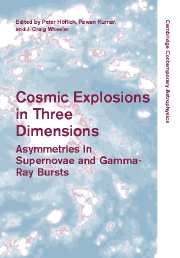Book contents
- Frontmatter
- Contents
- Part I Introduction
- Part II Supernovae: Observations Today
- 2 Supernova explosions: lessons from spectropolarimetry
- 3 Spectropolarimetric observations of supernovae
- 4 Observed and physical properties of Type II plateau supernovae
- 5 SN 1997B and the different types of Type Ic supernovae
- 6 Near-infrared spectroscopy of stripped-envelope supernovae
- 7 Morphology of supernova remnants
- 8 The evolution of supernovae in the winds of massive stars
- 9 Types for the galactic supernovae
- Part III Theory of Thermonuclear Supernovae
- Part IV Theory of Core Collapse Supernovae
- Part V Magnetars, N-Stars, Pulsars
- Part VI Gamma-ray Bursts
- Part VII Conference Summary
- References
8 - The evolution of supernovae in the winds of massive stars
Published online by Cambridge University Press: 11 August 2009
- Frontmatter
- Contents
- Part I Introduction
- Part II Supernovae: Observations Today
- 2 Supernova explosions: lessons from spectropolarimetry
- 3 Spectropolarimetric observations of supernovae
- 4 Observed and physical properties of Type II plateau supernovae
- 5 SN 1997B and the different types of Type Ic supernovae
- 6 Near-infrared spectroscopy of stripped-envelope supernovae
- 7 Morphology of supernova remnants
- 8 The evolution of supernovae in the winds of massive stars
- 9 Types for the galactic supernovae
- Part III Theory of Thermonuclear Supernovae
- Part IV Theory of Core Collapse Supernovae
- Part V Magnetars, N-Stars, Pulsars
- Part VI Gamma-ray Bursts
- Part VII Conference Summary
- References
Summary
Abstract
We study the evolution of supernova remnants in the circumstellar medium formed by mass loss from the progenitor star. The properties of this interaction are investigated, and the specific case of a 35 M⊙ star is studied in detail. The evolution of the SN shock wave in this case may have a bearing on other SNRs evolving in wind-blown bubbles, especially SN 1987A.
Introduction
Type II Supernovae are the remnants of massive stars (M > 8 M⊙). As these stars evolve along the main sequence, they lose a considerable amount of mass, mainly in the form of stellar winds. The properties of this mass loss may vary considerably among different evolutionary stages. The net result of the expelled mass is the formation of circumstellar wind-blown cavities, or bubbles, around the star, bordered by a dense shell. When the star ends its life as a supernova, the resulting shock wave will interact with this circumstellar bubble rather than with the interstellar medium. The evolution of the shock wave, and that of the resulting supernova remnant (SNR), will be different from that in a constant density ambient medium.
In this work we study the evolution of supernova remnants in circumstellar wind-blown bubbles. The evolution depends primarily on a single parameter, the ratio of the mass of the shell to that of the ejected material. Various values of this parameter are explored.
- Type
- Chapter
- Information
- Cosmic Explosions in Three DimensionsAsymmetries in Supernovae and Gamma-Ray Bursts, pp. 74 - 80Publisher: Cambridge University PressPrint publication year: 2004
References
- 4
- Cited by



